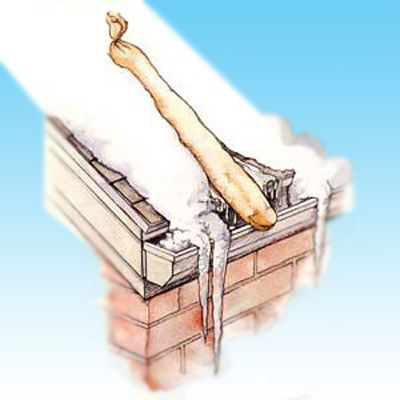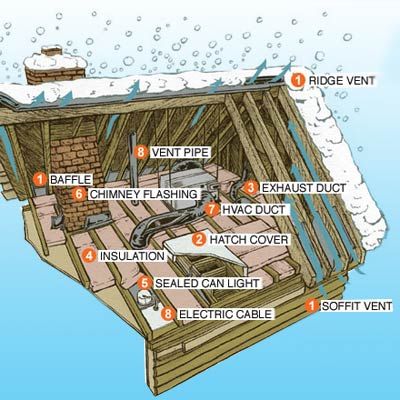Icicles hanging along your home’s eaves may look beautiful, but they spell trouble. The same conditions that let them form also let ice dams take hold. These thick ridges of solid ice build up along the eaves and could damage your roof and gutters if left unmitigated.
What Are Ice Dams?
Ice dams occur when snow melts on a warm roof and the water refreezes across the eaves. As more water melts high up on the roof, it backs up behind the ice. When that water freezes, the dam grows further.
Outdoors, the sheer weight of an ice dam can tear off your gutters or loosen your shingles. This, however, only scratches the surface of the carnage they can cause.
When enough water is behind the ice dam and there’s no other place for it to go, it can get underneath the shingles and find its way into your home’s interior. That might lead to stained and warped floors, damaged insulation, sagging ceilings, and potential mold growth that can be expensive to remediate.
How To Prevent Ice Dams
You can install heated roof cables to prevent ice dams from forming in the first place.
Heated Cables
Attached with clips along the roof’s edge in a zigzag pattern, heated cables help prevent ice dams that lift shingles and cause leaks. This solution allows you to equalize your roof’s temperature by heating it from the outside instead of blowing in cold air from the inside (as mentioned in “Fast Fixes for Ice Dams“). Just be sure to install the cables before bad weather hits.
For more information on this and other electronic snow and ice melters, see Plug-in Snow Busters.
Keep reading for fast fixes you can do yourself after a dam has already formed.
Removing Existing Ice Dams
If you already have ice dams, there are several methods to remove them safely:
Apply Cold Air
For a quick fix when water is actively leaking, take a box fan into the attic and aim it at the underside of the roof where the leak is happening. The targeted cold air should help the water freeze.
This fix is by no means permanent, but it can buy you some time to make a more permanent fix.
Use a Roof Rake
A long-handled aluminum roof rake can help you safely remove snow from your roof and deposit it onto the ground. Choose a rake with wheels, which will be much gentler on your shingles.
The Pantyhose Method

You can also diminish the damage after the dam has formed with… pantyhose! Fill the leg of a discarded pair of pantyhose with a calcium chloride ice melter. Lay the hose onto the roof so it crosses the ice dam and overhangs the gutter.
If necessary, use a long-handled garden rake or hoe to push it into position. The calcium chloride will eventually melt through the snow and ice and create a channel for water to flow down into the gutters or off the roof.
Here’s a list of long-term fixes that will help you get rid of your ice dams for good.
Permanent Fixes for Ice Dams

Getting rid of ice dams for good is simple, in principle. Keep the entire roof the same temperature as the eaves. You do that by increasing ventilation, adding insulation, and sealing off every possible air leak that might warm the underside of the roof.
By taking care of common trouble spots, listed here in order of priority, you should enjoy dam-free winters by winterizing your roof and using less energy to boot:
- Ventilate eaves and ridges. A ridge vent paired with continuous soffit vents circulates cold air under the entire roof. Both ridge and soffit vents should have the same size openings and provide at least 1 square foot of opening for every 300 square feet of attic floor. Place baffles at the eaves to maintain a clear path for the airflow from the soffit vents.
- Cap the hatch. An unsealed attic hatch or whole-house fan is a massive opening for heat to escape. Cover them with weather-stripped caps made from foil-faced foam board held together with aluminum tape.
- Exhaust to the outside. Make sure that the ducts connected to the kitchen, bathroom, and dryer vents all lead outdoors through either the roof or walls, but never through the soffit.
- Add insulation. More insulation on the attic floor keeps the heat where it belongs. Check with your local building department to find out how much insulation your attic needs.
- Install sealed can lights. Old-style recessed lights give off great plumes of heat and can’t be insulated without creating a fire hazard. Replace them with sealed “IC” fixtures, which can be covered with insulation.
- Flash around chimneys. Bridge the gap between the chimney and house framing with L-shaped steel flashing held in place with unbroken beads of a fire-stop sealant. Using canned spray foam or insulation isn’t fire-safe.
- Seal and insulate ducts. Spread fiber-reinforced mastic on the joints of HVAC ducts and exhaust ducts. Cover them entirely with R-5 or R-6 foil-faced fiberglass.
- Caulk any other leaky spots. Seal around electrical cables and vent pipes with a fire-stop sealant. Also, look for any spots where the light shines up from below or the insulation is stained black by the dirt from passing air.
